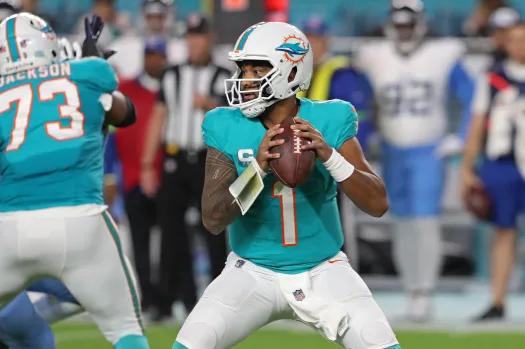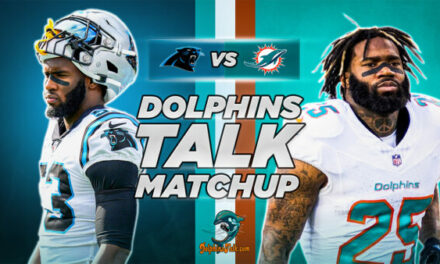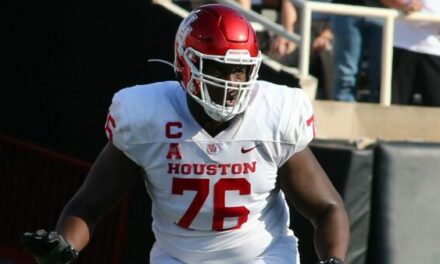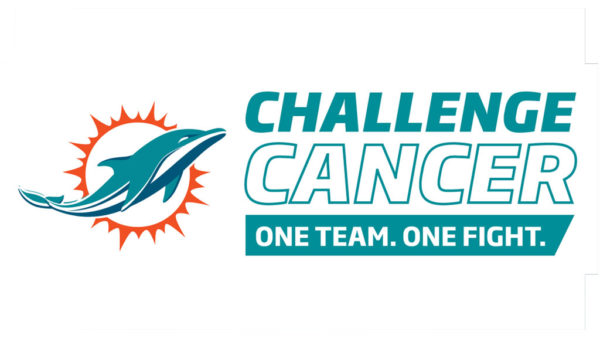The Miami Dolphins suffered a significant upset in Week 14, blowing a 14-point lead to the Tennessee Titans. It was arguably the most improbable comeback in NFL history, according to NextGenStats.
When a collapse that brutal happens, it takes a village. There’s a ton of blame to go around on all sides of this for the Dolphins. Defense, offense, special teams, and coaching contributed to their defeat.
However, the purpose of this column is to evaluate quarterback play, and that’s what we’ll do this week. Tua Tagovailoa finished the game, completing 23 of 33 passes for 255 yards for zero touchdowns and interceptions.
It was the first time Tagovailoa didn’t throw a touchdown pass (in a game he started and finished) since, you guessed it, his matchup with the Titans during the 2021 season.
Let’s dive into the film and see what the Titans cooked up to knock Tagovailoa and the Dolphins’ offense off its game.
Tua All-22 vs. Titans
What Went Wrong?
Doesn’t wanna try to the tight window to Berrios like he does with Hill, and AJ whiffs. pic.twitter.com/hVqRS0RYi3
— Dante Collinelli (@DanteCollinelli) December 12, 2023
A lot. Okay, getting a little more specific, this play is an excellent example of why Miami’s offense struggled on Monday night. There are a few things to pay attention to with this play.
For starters, look at Braxton Berrios at the top of the screen. He’s Tagovailoa’s primary read on this play, and he’s running a classic Dolphins’ in-breaker while Durham Smythe is running a wheel/vertical behind it.
Next, let’s look at Tagovailoa. Watch him take his drop and pause the video when his back foot hits. See where Berrios is? He’s not even close to getting into the throwing window, but Tagovailoa is ready to throw.
Lastly, take a peek at Austin Jackson trying to block at right tackle. He completely whiffs on his punch, allowing immediate pressure on Tagovailoa.
What does that equal? An incomplete pass.
This play encapsulates a problem the Dolphins have struggled with all season. Miami’s other receivers are not Tyreek Hill. The star receiver was in the game on this play, but he’s the decoy man on the pre-snap motion.
Tagovailoa’s back foot hits, and he doesn’t quite trust Berrios to make the type of play Hill would. We’ve seen Tagovailoa hit tighter windows than this before, and we’ve seen him throw the ball this early before. But for some reason, he hesitates.
That hesitation likely stems from Berrios’ suboptimal route, but that hasn’t stopped Tagovailoa before. So what stopped him this time? A lack of trust in Berrios? This was later in the game, so were things just off the hinges at that point?
It’s hard to say, but that slight hesitation allowed pressure to get home on a play it usually wouldn’t, even though Jackson was beaten badly.
Back foot hits, he’s looking at Wilson, and doesn’t pull the trigger. He’s hit way tougher windows than this before, too. pic.twitter.com/PjVyERwpt4
— Dante Collinelli (@DanteCollinelli) December 12, 2023
Let’s look at a similar but slightly different example. Tagovailoa’s first read is Cedrick Wilson’s in-breaker at the top of the screen.
This time, his drop is better timed with the actual route. Tagovailoa’s back foot hits, and Wilson is just starting his break. Tagovailoa stares at Wilson as he breaks open and doesn’t throw the football.
The cornerback would’ve arrived quickly, but again, Tagovailoa has hit much tighter windows than this in the past. To make matters worse, Tagovailoa starts pumping and unsets his feet instead of simply moving to the next route in the progression.
Also, pay attention to the offensive line. There isn’t an immediate win off the snap, but the Titans’ pressure muddies up the pocket, preventing Tagovailoa from stepping up.
The combination of pressure and a trigger-shy Tagovailoa showed up all over Monday’s film outside of Miami’s first drive off the game.
Miscommunications
Tua looks like he’s going to break the pocket so Waddle snaps outside, but Tua throws inside. Very lucky it wasn’t picked. pic.twitter.com/Ong6tjcPxX
— Dante Collinelli (@DanteCollinelli) December 12, 2023
Another part of this equation is Tagovailoa not being on the same page as his receivers. Tagovailoa didn’t throw an interception on Monday, but he probably should’ve on this throw.
It’s difficult to tell exactly what this concept is supposed to be because the play breaks down. However, our best guess is Waddle and Berrios’ underneath crossers are supposed to tie down zone defenders, allowing Wilson’s crossing route to open on the other side.
Tagovailoa can also just throw the underneath crossers if he likes the matchup or the picture changes pre-snap. The Titans get quick but not immediate pressure, forcing Tagovailoa off his spot.
Waddle sees this and breaks his route to the outside. However, Tagovailoa throws it back across the middle where he thinks Waddle is going, and Amani Hooker almost intercepts it.
Two things about this play.
One, Waddle was right to enter the scramble drill. Tagovailoa should’ve pushed to get outside the pocket and make a throw. Throwing from that platform across the middle is a sin.
Two, Hooker played a “robber role” all night for the Titans, and it screwed up a lot of the Dolphins’ concepts. He just stood in the middle of the field with his hips to the sideline and erased whatever in-breaker Waddle or Hill was running.
Probably one of Tua’s better throws and Achane’s slight hesitation forces the incompletion — brutal. pic.twitter.com/JypnR1oYIp
— Dante Collinelli (@DanteCollinelli) December 12, 2023
This miscommunication is more straightforward to explain. De’Von Achane hesitates at the top of his route, meaning he ends up short of a well-thrown pass from Tagovailoa.
The Dolphins took advantage of the Titans constantly dropping one of their safeties into the robber role. Watch Hooker on this play. He rotates down into the middle of the field and then has to sprint outside the numbers when Achane beats Murphy-Bunting.
It’s a perfect call and throw, but the Dolphins just aren’t on the same page, so it’s another harmless incompletion and missed opportunity.
Why Did This Happen?
Simply put, the Dolphins’ passing offense doesn’t have an answer when teams can generate pressure without blitzing. Tagovailoa is excellent against the blitz; that’s not a problem.
But when the opposing team can generate pressure and drop all its defenders into coverage, Tagovailoa and the Dolphins’ offense at large struggles.
The passing offense is designed to maximize Tagovailoa’s (accuracy, anticipation) and Hill’s (speed) elite traits. Roughly 90 percent of Miami’s passing offense is point-and-shoot. Tagovailoa lets go of the ball so quickly that pressure can’t arrive, and Hill is so fast defenses can’t stop him from getting to spots before they do.
However, Hill is such a unique player that the Dolphins’ offense sputters when he’s out (like most of Monday’s game). You can’t scheme up a way to replace Hill’s speed.
No version of Wilson or Berrios will get to spots like Hill. Waddle is close, but even his connection with Tagovailoa isn’t as potent. So, when the entire fabric of the offense is constructed off of Hill’s speed, it’s impossible to adapt mid-game.
The same goes for the other half of this equation — pressure. The Dolphins were missing four starters upfront against the Titans. Typically, the ball is out of Tagovailoa’s hands before pressure can arrive, so that wouldn’t matter.
But, without Hill, Tagovailoa had to hold the ball longer, giving the Titans more time to expose Miami’s backup linemen. So injuries are to blame for everything? Not at all.
Miami has had the same problem in every loss this season. The team’s worst PFF pass-blocking grades have all come in losses to the Eagles, Bills, and Titans. The Dolphins were healthier for those games, and Hill was in the lineup for the first two.
Last night’s injuries only exacerbated Miami’s problems; they’re not the root cause. Good defenses will give the Dolphins problems, even when Miami is at full strength.
The Dolphins’ passing offense is unique and creative, but it can’t operate efficiently when things are off schedule, or their first read is erased from the concept. The Dolphins have full-field reads in their offense, but they make up such a small percentage of the team’s actual calls.

What Does This Say About Tua?
This year’s column aims to determine Tagovailoa’s place in the quarterback hierarchy. He’s become a “good” NFL quarterback and has made legitimate strides in improving parts of his game.
None of what happened against the Titans changes that. Tagovailoa is still a “good” NFL quarterback, and he’s still having the best season of his career.
With all of that said, there is a limit to what Tagovailoa can accomplish right now. The Dolphins’ problems with pressure are equally due to the offense’s design and Tagovailoa.
Tagovailoa isn’t athletic enough to solve problems consistently. He’s at his best when working within the structure of the offense. The elite quarterbacks all face the same problem Tagovailoa is right now.
Most offenses struggle when teams can pressure with four and drop eight into coverage. That’s not a unique knock on the Dolphins or Tagovailoa. However, the truly elite quarterbacks can use their physical talent to turn negative plays into positive ones.
Tagovailoa isn’t that player right now. He’s not the quarterback who will make an offense laden with injuries suddenly elite, especially against a well-coached defense.
This isn’t different than the take we had after the Eagles game. Tagovailoa was far from Miami’s most significant problem in that football game, but how he played still wasn’t good enough. That was the case against the Titans.
Tagovailoa had a chance to drive Miami down the field for a game-winning drive and say “Even when things are going horrible, I can flip the switch and will my team to victory.” But it just didn’t happen.
We’ll wait until the end of the season to say that’s who Tagovailoa is — a good but not great quarterback. He has chances to put a defining win on his resume against the Ravens, Cowboys, and Bills.
Although it feels like it, the sky isn’t falling. The Dolphins will more than likely make the postseason, giving Tagovailoa another chance to take the next step.
Monday shouldn’t move your opinion of Tagovailoa. He’s still good but needs to take an additional step to become elite. Opportunities remain, but time is starting to run out now.













